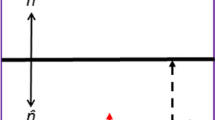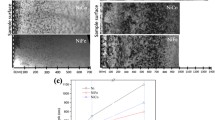Abstract
In this paper, we investigate the role that the atomic structure of grain boundaries (GBs) in Ni has in the interaction with point defects produced during the collision cascades. Using molecular dynamics and statics, we study the influence of different GB structures on the production and evolution of defects, through calculation of defect formation energy, vacancy diffusion barrier, interstitial-vacancy annihilation barrier, and the corresponding energetic and kinetic influence ranges near pristine and damaged GBs. We observe that, as previously reported, GBs preferentially absorb interstitials over vacancies, which result in accumulation of vacancies in the bulk grain and interstitials to highly localize at the GBs. Also, we find that, in several layers near the GBs, the formation energy of defects is substantially reduced, indicating that the GBs serve as a sink for the radiation-produced defects. Further investigation also reveals that the sink strength of the GBs is significantly stronger for interstitials than vacancies. Also in terms of kinetic behavior, we find that the energy barrier of vacancy diffusion reduces as the defect migrates to the close vicinity of the GBs, implying that in the presence of thermally assisted events, vacancies diffuse toward the GBs via low-barrier processes, which result in healing of the damaged boundaries at high temperatures. Moreover, we observe that in the neighboring region of the defect-loaded GBs, the annihilation of a close vacancy–interstitial pair is spontaneous. Finally, via continuous ion bombardment simulation, we study the stability of the GBs in severe irradiation condition. We find that the GBs lose their stability as the number of trapped interstitials increases at the GB plane. Besides, we conclude that the GBs have high efficiency in defect removal on picosecond time scale and act as efficient defect sinks, despite the instability and saturation observed in repeated ion bombardments.








Similar content being viewed by others
References
Nickel (the magazine devoted to nickel and its application), special report: the revival of nuclear power, (2006) vol. 21, no. 4 (ISSN: 0829-8351)
Rowcliffe AF, Mansur LK, Hoelzer DT, Nanstad RK (2009) Perspectives on radiation effects in nickel-base alloys for applications in advanced reactors. J Nucl Mater 392(2):341–352. doi:10.1016/j.jnucmat.2009.03.023Z
Al Tooq Z, Kenny SD (2013) Modelling radiation damage at grain boundaries in fcc nickel and Ni-based alloy using long time scale dynamics techniques. Nucl Instrum Methods Phys Res B 303:9–13. doi:10.1016/j.nimb.2012.10.027
Allen T et al. (eds) (2002). High temperature materials workshop, ANL-02/12, Argonne National Laboratory
Chant I, Murty KL (2010) Structural materials issues for the next generation fission reactors. JOM 62(9):67–74. doi:10.1007/s11837-010-0142-3
Yvon P, Carré F (2009) Structural materials challenges for advanced reactor systems. J Nucl Mater 385(2):217–222. doi:10.1016/j.jnucmat.2008.11.026
Chen Di, Wang J, Chen T, Shao L (2013) Defect annihilation at grain boundaries in alpha-Fe. Sci Rep. doi:10.1038/srep01450
Rose M, Balogh AG, Hahn H (1997) Instability of irradiation induced defects in nanostructured materials. Nucl Instrum Methods Phys Res B 127–128:119–122. doi:10.1016/s0168-583x(96)00863-4
Chimi Y, Iwase A, Ishikawa N, Kobiyama M, Inami T, Okuda S (2001) Accumulation and recovery of defects in ion-irradiated nanocrystalline gold. J Nucl Mater 297(3):355–357. doi:10.1016/s0022-3115(01)00629-8
Nita N, Schaeublin R, Victoria M (2004) Impact of irradiation on the microstructure of nanocrystalline materials. J Nucl Mater 329–333:953–957. doi:10.1016/j.jnucmat.2004.04.058
Wirth B, Bulatov V, Diaz de la Rubia T (2000) Atomistic simulation of stacking fault tetrahedra formation in Cu. J Nucl Mater 283–287:773–777. doi:10.1016/s0022-3115(00)00262-2
Arakawa K, Ono K, Isshiki M, Mimura K, Uchikoshi M, Mori H (2007) Observation of the one-dimensional diffusion of nanometer-sized dislocation loops. Science 318(5852):956–959. doi:10.1126/science.1145386
Wirth BD (2007) Materials science: how does radiation damage materials? Science 318(5852):923–924. doi:10.1126/science.1150394
Soneda N, de la Rubia TD (1998) Defect production, annealing kinetics and damage evolution in α-Fe: an atomic-scale computer simulation. Philos Mag A 78(5):995–1019. doi:10.1080/01418619808239970
Cawthorne C, Fulton EJ (1967) Voids in irradiated stainless steel. Nature 216(5115):575–576. doi:10.1038/216575a0
de la Rubia TD, Zbib HM, Khraishi TA, Wirth BD, Victoria M, Caturla MJ (2000) Multiscale modelling of plastic flow localization in irradiated materials. Nature 406(6798):871–874. doi:10.1038/35022544
Singh BN, Foreman AJE, Trinkaus H (1997) Radiation hardening revisited: role of intracascade clustering. J Nucl Mater 249(2–3):103–115. doi:10.1016/s0022-3115(97)00231-6
Shaikh MA, Iqbal M, Ahmad M, Akhtar JI, Shoaib KA (1992) Precipitation study of heat-treated Incoloy 825 by scanning electron microscopy. J Mater Sci Lett 11(14):1009–1011. doi:10.1007/bf00729911
Yamada R, Zinkle SJ, Pells GP (1992) Defect formation in ion-irradiated Al2O3 and MgAl2O4: effects of grain boundaries and fusion transmutation products. J Nucl Mater 191–194:640–644. doi:10.1016/s0022-3115(09)80125-6
Alimov VK, Roth J, Mayer M (2005) Depth distribution of deuterium in single- and polycrystalline tungsten up to depths of several micrometers. J Nucl Mater 337–339:619–623. doi:10.1016/j.jnucmat.2004.10.082
Swaminathan N, Kamenski PJ, Morgan D, Szlufarska I (2010) Effects of grain size and grain boundaries on defect production in nanocrystalline 3C–SiC. Acta Mater 58(8):2843–2853. doi:10.1016/j.actamat.2010.01.009
Shen TD, Feng S, Tang M, Valdez JA, Wang Y, Sickafus KE (2007) Enhanced radiation tolerance in nanocrystalline MgGa2O4. Appl Phys Lett 90(26):263115. doi:10.1063/1.2753098
Misra A, Demkowicz MJ, Zhang X, Hoagland RG (2007) The radiation damage tolerance of ultra-high strength nanolayered composites. JOM 59(9):62–65. doi:10.1007/s11837-007-0120-6
Atwater HA, Brown WL (1990) Grain boundary mediated amorphization in silicon during ion irradiation. Appl Phys Lett 56(1):30. doi:10.1063/1.102637
Pérez Pérez FJ, Smith R (1999) Modelling radiation effects at grain boundaries in bcc iron. Nucl Instrum Methods Phys Res B 153(1–4):136–141. doi:10.1016/s0168-583x(99)00197-4
Samaras M, Derlet PM, Van Swygenhoven H, Victoria M (2003) Radiation damage near grain boundaries. Philos Mag 83(31–34):3599–3607. doi:10.1080/14786430310001600222
Samaras M, Derlet PM, Van Swygenhoven H, Victoria M (2003) Stacking fault tetrahedra formation in the neighborhood of grain boundaries. Nucl Instrum Methods Phys Res Sect B 202:51–55. doi:10.1016/s0168-583x(02)01829-3
Suzuki A, Mishin Y (2003) Atomistic modeling of point defects and diffusion in copper grain boundaries. Interface Sci 11(1):131–148. doi:10.1023/a:1021599310093
Suzuki A, Mishin Y (2005) Atomic mechanisms of grain boundary diffusion: low versus high temperatures. J Mater Sci 40(12):3155–3161. doi:10.1007/s10853-005-2678-0
Suzuki A, Mishin Y (2003) Interaction of point defects with grain boundaries in fcc metals. Interface Sci 11(4):425–437. doi:10.1023/a:1026195911339
Tschopp MA, Solanki KN, Gao F, Sun X, Khaleel MA, Horstemeyer MF (2012) Probing grain boundary sink strength at the nanoscale: energetics and length scales of vacancy and interstitial absorption by grain boundaries in α-Fe. Phys Rev B 85(6):064108. doi:10.1103/physrevb.85.064108
Tschopp MA, Mcdowell DL (2007) Asymmetric tilt grain boundary structure and energy in copper and aluminum. Philos Mag 87(25):3871–3892. doi:10.1080/14786430701455321
Blackwell S, Smith R, Kenny SD, Walls JM (2011) Modeling the sputter deposition of thin film photovoltaics using long time scale dynamics techniques. MRS Proc 1327:56–61. doi:10.1557/opl.2011.1124
Kurishita H, Kuwabara T, Hasegawa M, Kobayashi S, Nakai K (2005) Microstructural control to improve the resistance to radiation embrittlement in vanadium. J Nucl Mater 343(1–3):318–324. doi:10.1016/j.jnucmat.2004.12.017
Tian XF, Gao T, Xiao HX, Lu CH (2013) Dynamical simulations of displacement cascades near symmetrical tilt grain boundaries in UO2. Indian J Phys 88(2):137–143. doi:10.1007/s12648-013-0400-7
Zhang CG, Zhou WH, Li YG, Zeng Z, Ju X (2015) Primary radiation damage near grain boundary in bcc tungsten by molecular dynamics simulations. J Nucl Mater 458:138–145. doi:10.1016/j.jnucmat.2014.11.135
Bai X-M, Vernon LJ, Hoagland RG, Voter AF, Nastasi M, Uberuaga BP (2012) Role of atomic structure on grain boundary-defect interactions in Cu. Phys Rev B 85(21):214103. doi:10.1103/physrevb.85.214103
Bai XM, Voter AF, Hoagland RG, Nastasi M, Uberuaga BP (2010) Efficient annealing of radiation damage near grain boundaries via interstitial emission. Science 327(5973):1631–1634. doi:10.1126/science.1183723
Li X, Liu W, Xu Y, Liu CS, Fang QF, Pan BC, Chen JL, Luo GN, Wang Z (2013) An energetic and kinetic perspective of the grain-boundary role in healing radiation damage in tungsten. Nucl Fusion 53(12):123014. doi:10.1088/0029-5515/53/12/123014
Herzig C, Mishin Y, Divinski S (2002) Bulk and interface boundary diffusion in group IV hexagonal close-packed metals and alloys. Metall Mater Trans A 33(13):765–775. doi:10.1007/s11661-002-1006-4
Watanabe S, Takamatsu Y, Sakaguchi N, Takahashi H (2000) Sink effect of grain boundary on radiation-induced segregation in austenitic stainless steel. J Nucl Mater 283–287:152–156. doi:10.1016/s0022-3115(00)00204-x
Sørensen MR, Mishin Y, Voter AF (2000) Diffusion mechanisms in Cu grain boundaries. Phys Rev B 62(6):3658–3673. doi:10.1103/physrevb.62.3658
Lee H-S, Mizoguchi T, Mistui J, Yamamoto T, Kang S-JL, Ikuhara Y (2011) Defect energetics in SrTiO3 symmetric tilt grain boundaries. Phys Rev 83(10):104110. doi:10.1103/physrevb.83.104110
Kurtz RJ, Heinisch H (2004) the effects of grain boundary structure on binding of He in Fe. J Nucl Mater 329–333:1199–1203. doi:10.1016/j.jnucmat.2004.04.262
Ogawa H (2006) GBstudio: a builder software on periodic models of CSL boundaries for molecular simulation. Mater Trans 47(11):2706–2710. doi:10.2320/matertrans.47.2706
Plimpton S (1995) Fast parallel algorithms for short-range molecular dynamics. J Comput Phys 117(1):1–19. doi:10.1006/jcph.1995.1039
Bonny G, Castin N, Terentyev D (2013) Interatomic potential for studying ageing under irradiation in stainless steels: the FeNiCr model alloy. Model Simul Mater Sci Eng 21(8):085004. doi:10.1088/0965-0393/21/8/085004
Ziegler JF, Biersack JP (1985) The stopping and range of ions in matter. In: Bromley DA (ed) Treatise on heavy-ion science. Springer, Berlin, p 93–129. doi:10.1007/978-1-4615-8103-1_3
Li X, Xu Y, Liu CS, Fang QF, Pan BC, Wang Z (2013) Energetic and kinetic behaviors of small vacancy clusters near a symmetric Σ5(310)/[001] tilt grain boundary in bcc Fe. J Nucl Mater 440(1–3):250–256. doi:10.1016/j.jnucmat.2013.05.021
Honeycutt JD, Andersen HC (1987) Molecular dynamics study of melting and freezing of small Lennard-Jones clusters. J Phys Chem 91(19):4950–4963. doi:10.1021/j100303a014
Henkelman G, Jóhannesson G, Jónsson H (2002) Methods for finding saddle points and minimum energy paths. In: Schwartz SD (ed) Progress in theoretical chemistry and physics. Kluwer Academic, Dordrecht, p 269–302. doi:10.1007/0-306-46949-9_10
Henkelman G, Uberuaga BP, Jónsson H (2000) A climbing image nudged elastic band method for finding saddle points and minimum energy paths. J Chem Phys 113(22):9901. doi:10.1063/1.1329672
Stukowski A (2009) Visualization and analysis of atomistic simulation data with OVITO–the open visualization tool. Model Simul Mater Sci Eng 18(1):015012. doi:10.1088/0965-0393/18/1/015012
Tsuchihira H, Oda T, Tanaka S (2011) Displacement cascade simulation of LiAlO2 using molecular dynamics. J Nucl Mater 414(1):44–52. doi:10.1016/j.jnucmat.2011.04.064
Xu CP, Liu X-Y, Gao F, Li YH, Wang YQ (2014) Modeling radiation damage near grain boundary in helium-doped α-iron. Nucl Instrum Methods Phys Res B 332:426–431. doi:10.1016/j.nimb.2014.02.111
Sørensen MR, Voter AF (2000) Temperature-accelerated dynamics for simulation of infrequent events. J Chem Phys 112(21):9599. doi:10.1063/1.481576
Lejček P (2010) Introduction. Grain boundary segregation in metals. Springer, Berlin. p. 1–4. doi:10.1007/978-3-642-12505-8_1
Uberuaga BP, Bai X-M (2011) Defects in rutile and anatase polymorphs of TiO2: kinetics and thermodynamics near grain boundaries. J Phys Condens Matter 23(43):435004. doi:10.1088/0953-8984/23/43/435004
Bai X-M, Uberuaga BP (2012) Multi-timescale investigation of radiation damage near TiO2 rutile grain boundaries. Philos Mag 92(12):1469–1498. doi:10.1080/14786435.2011.648229
Author information
Authors and Affiliations
Corresponding author
Electronic supplementary material
Below is the link to the electronic supplementary material.
Rights and permissions
About this article
Cite this article
Arjhangmehr, A., Feghhi, S.A.H., Esfandiyarpour, A. et al. An energetic and kinetic investigation of the role of different atomic grain boundaries in healing radiation damage in nickel. J Mater Sci 51, 1017–1031 (2016). https://doi.org/10.1007/s10853-015-9432-z
Received:
Accepted:
Published:
Issue Date:
DOI: https://doi.org/10.1007/s10853-015-9432-z




